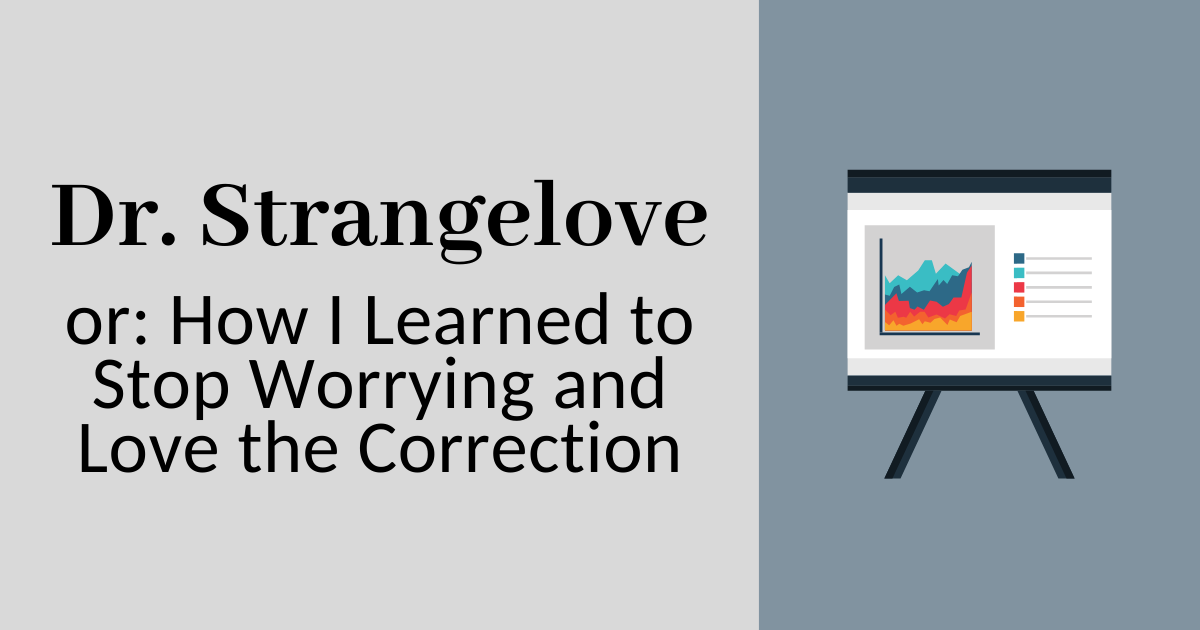Dr. Strangelove or: How I Learned to Stop Worrying and Love the Correction
With apologies to Stanley Kubrick, I’d like to expend some electronic ink to take a look at corrections, or downward adjustments in asset prices, as something to be expected and possibly even looked forward to. While corrections can occur in all sorts of indexes and markets, from commodities to currencies, we will concern ourselves with corrections in stock market indexes.
First, at least one clarification is in order. In speaking of corrections in this piece, I am referring to price declines in asset price indexes, not individual securities. So, for example, we will concern ourselves with price declines in something like the Standard & Poor’s 500 index, rather than with a price decline in Tesla, or some other stock.
Second, there’s an old joke about politicians—‘goes something like, how do you know when a politician is lying? His lips are moving. In my mind, there could be a somewhat similar saying about corrections and market pundits: how do you know when a market pundit is lying? When he says he knows why a market is correcting. There is no single reason, nor any finite list of reasons, for why markets correct. There may be catalysts for corrections, or as some like to say, excuses to sell, but with volumes of shares traded measured in the 100s of millions, there is no way to know the cause of corrections.
So, do corrections serve any useful function?
One useful function of corrections is to shake out the marginal investors, the Johnny-come-latelys—to use another phrase. When markets rise in uninterrupted fashion, they tend to attract investors who mistake the relative tranquility for something that might offer a free ride of rising stock prices. In the current environment, these might be investors who are reaching for returns higher than the meager fixed-income yields they had heretofore experienced. One might think of this like a college course, which was said to have been a course intended to weed out students who didn’t belong in a particular major. What usually ended up weeding out the marginal students was a difficult test, and usually the test was difficult for all of the students.
Long term investors, and investors who are underinvested, should look at corrections as an opportunity to buy stocks at lower prices. Over time, famous value investors have relished these times to buy quality enterprises at lower prices, and in times of corrections, shares are said to trade hands from weak to strong investors, with the latter buying from the former. Also, participants in defined contribution retirement plans who are making regular contributions to their retirement plants should see corrections in similar lights.
Graig P. Stettner, CFA, CMT Strategence Capital, LLC
The opinions voiced in this material are for general information only and are not intended to provide specific advice or recommendations for any individual. All performance referenced is historical and is no guarantee of future results. All indices are unmanaged and may not be invested into directly.
The economic forecasts set forth in the presentation may not develop as predicted and there can be no guarantee that strategies promoted will be successful.
Bonds are subject to availability.
The market value of corporate bonds will fluctuate, and if the bond is sold prior to maturity, the investor’s yield may differ from the advertised yield.
The Standard & Poor’s 500 Index is a capitalization weighted index of 500 stocks designed to measure performance of the broad domestic economy through changes in the aggregate market value of 500 stocks representing all major industries.

